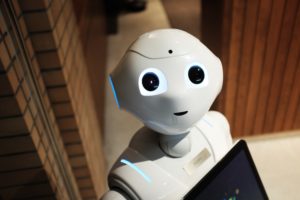As a keen science fiction and speculative design enthusiast, the idea of artificial intelligence (AI) and machine learning (ML) offers thrilling opportunities to imagine future transcending limits of technology and feasibility. However, we are still far away from an emotionally responsive AI i.e., machine consciousness, á la Terminator or the android on Lt. Co. Data on Star Trek: Next Generation.
On the other hand what we do have are complex algorithms, coding and learning systems programmed to respond in a prearranged manner to autonomously learn from its environment and progress into more intelligent algorithms in order to problem solve; almost like a human mind, but still, not quite like one. A relevant example of this is Amazon’s ‘Alexa’. Alexa can remember your last playlist and recommend a new one as per your musical preferences. It can provide helpful facts like the precise position of the sun on any given time of the day, however, it can’t yet offer a critically thoughtful opinion based on introspection, unless it is already in its databank.
Even in design, AI & ML empowers us to compute large sets of disparate, energetically evolving information and helps us make better design decisions. In other words, what machine logic can do in seconds; designers would need years and months to arrive at the exact same result. This ability to swiftly navigate through changing information and accurately respond is seeing earnest applications in the world of design.

Across technology driven design fields, AI & ML technologies are augmenting how we design and build the tangible artefacts and how that built design artefact responds to its user. Pick any disciple today whether Industrial Design, Communication Design, Fashion Design, Architecture and or Interior Design; AI and ML are gradually integrating with the use of Internet of Things, Augmented Reality/Virtual Reality, Automation & Robotics, Parametric Design & Architecture, UX/UI Interfaces, and even Health Care Design. Designers these days are using AI & ML tools like rapid prototyping, digital fabrication, design and coding of inter-connected devices, automated manufacturing and delivery systems, parametric architecture, game design and to create intuitive design solutions.
AI & ML technologies become even more applicable in Transdisciplinary Design, where multiple designs & non-design activities must work synchronously to produce large-scale and infinitely elaborate, intricate projects like urban city design.
Imagine a situation where a whole bunch of creatives like architects & interior designers, communication designers, industrial designers must bring their proficiency and skills together with government, engineers and city planners to design and create the next ‘smart’ city. The scope of such a project includes comprehending in detail things like city navigation, streets structures, landscaping, transportation, commercial & residential complexes, markets, interior spaces as well as all everyday products & objects like ceiling fans and furniture.
Because of AI & ML, we can now anticipate more accurately and therefore design far more holistically.
Using AI & ML, we can estimate and simulate sophisticated design differences by quickly deciphering large quantities of complex data from dense traffic patterns, climatic patterns, suitable construction techniques, efficient material application to the ecological footprint and even human behaviour, interactions or even peculiar user preferences all at once. It also allows unseen interdependencies to be visualised and thus, better solutions can be redesigned effectively, allowing intelligent, comfortable, seamless, intuitive design between users and their urban ecosystem. All of this is possible now barring reasonable constraints and concerns of cost, time and technology. In the future, feasibly we could even tweak and modify the design on command in real-time while living in such an urban utopia.
Still, we are left with the question that if machines can do all of this, what will designers be left with? Will there be scope for design industries in the future?
Two of the essential skills of a trained designer is empathy and creativity. While AI and ML enabled technology can crunch data and recreate patterns, they do lack in the abstraction of thought, germinating new ideas and deep emotional resonance are thus far and found only in the realms of a creative human mind.
Designers can comprehend the human context, rationalize contradictions and in fact find new applications for AI & ML. The future world needs both; while designers generate meaning and value, AI and ML can help us generate and deliver meaningful solutions at the cutting edge.
